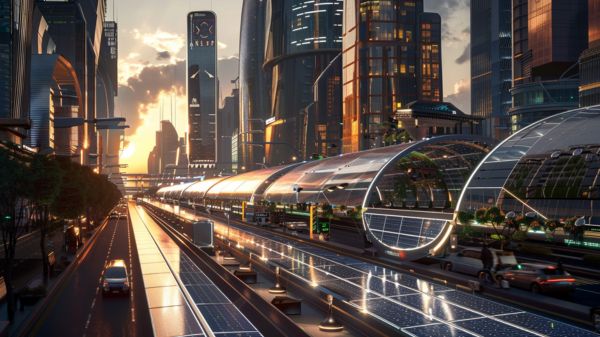You’ve heard of solar panels on rooftops, but have you considered the potential of floating solar farms harnessing water surfaces? These innovative technologies are paving the way for a new era of solar power generation in 2024 and beyond. From solar lighting advancements to solar skins and even solar-powered fabrics, the landscape of renewable energy is evolving rapidly. Stay tuned to discover how these top 5 emerging solar power technologies are reshaping the future of sustainable energy solutions.
Key Takeaways
- Floating solar farms utilize water surfaces for renewable energy generation.
- Solar lighting innovations revolutionize street lamps with cost-effective solar panels.
- Solar skins integration offers lightweight, customizable panels for enhanced aesthetics.
- Noise barrier technology converts sunlight into electricity while reducing noise pollution.
- Solar-powered fabrics integrate solar cells into clothing for on-the-go energy generation.
Floating Solar Farms
Floating solar farms represent a cutting-edge approach to harnessing solar energy by utilizing water surfaces for photovoltaic power generation. This innovative photovoltaic technology not only enhances energy production but also addresses critical global energy challenges.
By integrating floating solar panels on hydroelectric dams, these systems can greatly contribute to decarbonizing economies and promoting a sustainable energy shift. Additionally, the placement of floating solar farms on hydropower reservoirs helps reduce water evaporation, thereby conserving precious water resources for ideal hydropower generation.
Floating solar technology offers a unique solution to the dual challenges of energy production and water conservation. By covering just a fraction of the world’s hydropower reservoirs, floating solar farms have the potential to generate an impressive 4,000 gigawatts of electricity, showcasing the immense capacity of this technology.
Embracing floating solar farms isn’t just an innovative approach; it’s a vital step towards a greener future, where renewable energy sources play a pivotal role in shaping sustainable energy landscapes.
Solar Lighting Innovations
Utilizing solar panels and LED technology, solar lighting innovations revolutionize street lamps by efficiently harnessing sunlight for illumination, leading to reduced energy consumption.
Smart solar lighting systems are at the forefront of this transformation, utilizing the power of the sun during the day to light up streets at night, resulting in significant cost savings over traditional grid-powered lights. These advancements not only offer enhanced energy efficiency but also provide improved safety and security, particularly in remote or off-grid areas where reliable lighting is essential.
Moreover, the integration of solar panels and LED technology into lighting solutions plays an essential role in promoting sustainable practices and reducing carbon footprints. By opting for solar lighting innovations, communities can embrace environmentally friendly alternatives that not only benefit them economically but also contribute to a cleaner, greener future.
Embracing solar lighting solutions is a step towards a more sustainable and energy-efficient world, especially in off-grid areas where access to reliable lighting is essential for development and progress.
Related Post: The 7 Best Solar Powered Motion Sensor Flood Lights for Ultimate Outdoor Security.
Solar Skins Integration
Incorporating photovoltaic technology with stick-on designs, solar skins integration offers a sleek and lightweight solution to enhance solar energy generation on various surfaces. Solar skins provide a versatile solution that hides metal components, ensuring a clean and modern finish without the use of toxic materials.
Here are five key aspects of solar skins integration:
- Ten times lighter than traditional panels
- No toxic materials used
- Collect a wider spectrum of light through solar fabrics
- Increase energy conversion from 13.4% to 16.6%
- Flexible and customizable designs for enhanced aesthetics and functionality
Noise Barrier Technology
Noise barrier technology seamlessly integrates with emerging solar power technologies to convert sunlight into electricity while simultaneously reducing noise pollution.
These photovoltaic noise barriers serve as a modern solution to shield against unwanted noise, offering a contemporary alternative to traditional silicon solar panels.
By being installed over roofs, these innovative barriers not only generate renewable energy but also contribute to lowering home noise levels.
The environmental benefits of solar noise barriers are significant as they combine noise reduction with clean energy production, showcasing the dual functionality of solar panels in addressing noise pollution.
This dual-purpose technology represents a step forward in the field of renewable energy, providing a practical and efficient way to harness solar power while mitigating environmental noise.
Embracing this innovative technology not only promotes sustainability but also enhances the quality of living spaces by offering a multifaceted solution to noise disturbances.
Solar-Powered Fabrics
Solar fabrics revolutionize the concept of wearable technology by seamlessly integrating solar cells into clothing for on-the-go energy generation. These innovative fabrics aren’t only small and breathable but also ideal for fitness tracking and charging devices while you’re on the move.
The US Army is taking advantage of this technology, developing solar-powered robotic tents using solar fabric advancements. Collaboration with solar cell manufacturers is propelling the field forward, leading to various applications in wearable technology.
- Solar fabrics embed solar cells into clothing for wearable energy generation.
- These fabrics are small, breathable, and ideal for fitness tracking or charging devices on the go.
- The US Army is developing solar-powered robotic tents using solar fabric technology.
- Collaboration with solar cell manufacturers is driving advancements in solar fabric applications.
- Solar fabrics have the potential for diverse applications in the field of wearable technology.
Conclusion
As you navigate through the ever-evolving landscape of these 5 emerging solar power technologies, remember that these innovations are like seeds planted in the fertile soil of sustainability, blossoming into a colorful garden of clean energy solutions.
Embrace the floating solar farms, bask in the brilliance of solar lighting innovations, wrap yourself in the comfort of solar skins, shield yourself from noise with barrier technology, and wear the power of solar-powered fabrics with pride.
The future of energy is bright, vibrant, and sustainable.




